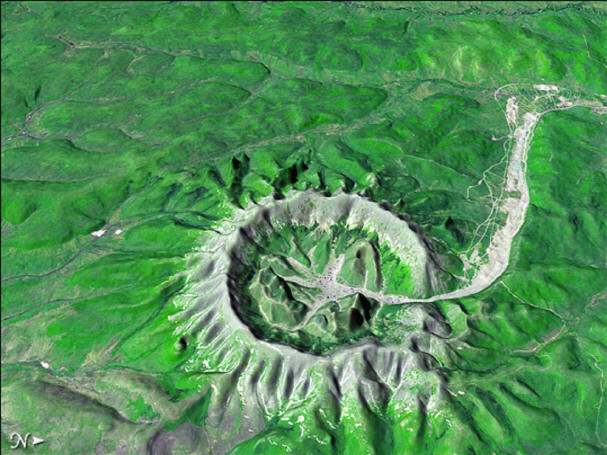
© Jesse Allen. Data courtesy of GSFC/METI/ERSDAC/JAROS and the U.S./Japan Aster Science Team
Geologists say it is an intrusion of igneous, or volcanic, rock that pushed up through overlying layers of sediment. Electric arcs provide a better explanation.
A six-kilometer-wide
circle of rock contrasts with the surrounding topography in Northern Siberia. It looks like a crater formed by the impact of a stone from space or an extinct volcano, but neither explanation seems to fit more detailed observations.
The Advanced Spaceborne Thermal Emission and Reflection Radiometer (ASTER) on NASA's Terra satellite observed Kondyor Massif on June 10, 2006. A three-dimensional image of the formation was created in order to provide an indication of its proportions. There is little vegetation within the ring of rock as the ASTER image reveals. A river flows out of the massif on the north side, fed by rainwater collecting within the uplifted rim.
An interesting feature of the river is that it appears to cut through the rim of the massif at one point, as if it adopted a channel that was present before the river began to flow. The geological term for such an anomaly is "
superimposed topography." In other words, the river and its bed seem to be inserted into the terrain, rather than developing with it.
Kondyor Massif is unique not just because of its unusual structure, but for the mineral veins within it: gold, silver, and platinum are mined there by the Russian government. Previous Picture of the Day articles about the
Siberian Traps and
Popigai Crater noted that northern Russia possesses rich diamond, copper, nickel, and coal deposits. Popigai is one of the world's most profitable diamond resources and includes one of the most concentrated examples of nickel-bearing ore in the world.
Kondyor is not an impact crater, per se, because the hallmarks of electrical activity are present. Circular formations all over the world are usually taken to be signs that an asteroid or a meteoroid struck with sufficient force that a hole was mechanically blasted out of the strata, leaving behind a crater as forensic evidence. However, most (if not all) of these patterns display characteristics that call into question the prevailing interpretation.
As we have written in the past, the
Manicouagan Impact Structure and
Kebira Crater (100 kilometers and 39 kilometers in width, respectively) do not fit the asteroid hypothesis. Concentric rings surround central uplifts; the interiors are wide and flat, with no blast debris; and neither formation has been "punched" into the Earth. Rather, they both resemble the circular formations visible on
the Moon and elsewhere in the Solar System. If there were no forests surrounding the Kondyor Massif, it would resemble
Terra Sirenum on Mars.
One of the most striking aspects to the large circular formations on Earth is that heavy metal mining takes place in all of them. The Sudbury Structure in Canada is a copper and copper sulfate mine. Popigai, as has been noted, is a nickel mine, and Manicouagan is a source for lead, copper, silver and gold. In western Canada, lying along a
giant arc that stretches from the Great Lakes to northern Saskatchewan, uranium is found in abundance. Much of the mining takes place underneath what were once large circular lakes that have been drained to accommodate operations.
What do these observations indicate? From an Electric Universe perspective, the presence of heavy metals is a result of neutron capture from an interplanetary thunderbolt. When electric discharges erupt into space, they do so because they are attracted to an oppositely charged leader that descends from the sky.
Kondyor Massif is round, with an upraised rim and deposits of heavy metals, because electric currents flowed into the center of the formation on their way to meet a descending leader-stroke from another charged object. Ions responded to the intense electric field and dragged the surrounding rock and soil with them toward space.
Meanwhile, the center of the main arc erupted in a titanic pillar of electric fire. The crater rim was uplifted and then fused in place, while the inrushing dendritic channels pulled the most electrically conductive minerals together into a consolidated mass. The rotating arc then left a shocked peak in the center of the maelstrom.
Kondyor is one of the remnants from circular augers of plasma that repeatedly devastated Siberia in the recent past.
Written by Stephen Smith from an idea suggested by Michael Steinbacher.
Reader Comments
to our Newsletter